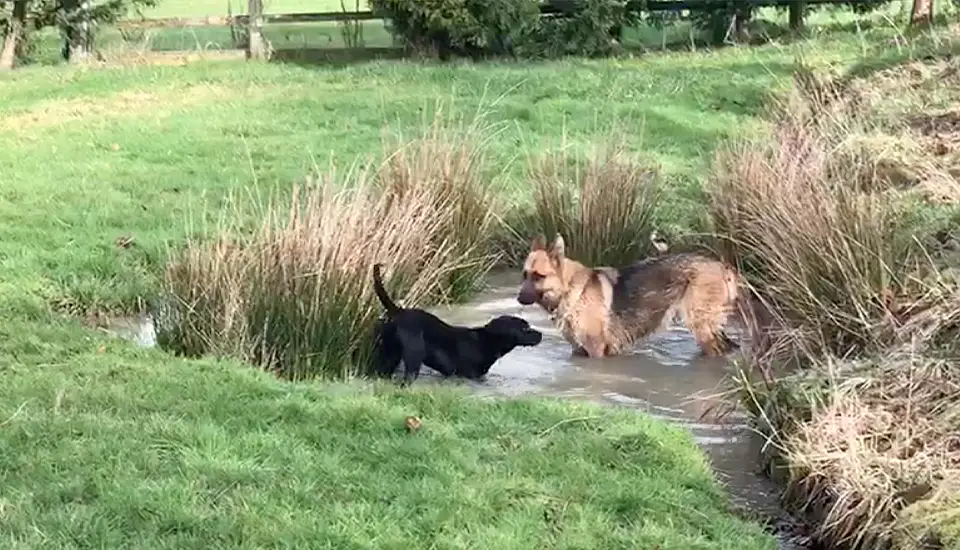Puppies first start to learn about the world through their interactions with other dogs. Initially, this is via their littermates and mother, and later, through their experiences with other dogs in their household, or ones they encounter out and about.
Many dogs mature to become excellent communicators; using a range of different methods to let other dogs and humans know how they are feeling, and what their intentions are. However, this is not something that is genetically hard-wired into them, it is something they must learn through safely managed interactions with other dogs.
During these interactions, pups will practice all kinds of different body language, visual cues and vocalisations, and note how the other dog reacts to them. Judging by these responses, a puppy can build a reliable picture of which behaviours are tolerated by other dogs, and which ones might get them into trouble!
Adult dogs can also have a lot to learn from puppies too; it’s not just a one-way street! Puppies are notoriously clumsy in their delivery, and they either tend to bound into situations with great enthusiasm, or with marked uncertainty. The reality of this can test the social skills of even the most well-socialised adult dog, because these pups don’t behave like the adult dogs they may be more used to spending time with.
I have recently recorded a fantastic example of an adult dog and puppy interaction, which clearly shows two commonly utilised behaviours from Nellie (my adult German Shepherd), and Penny (a client’s Labrador puppy).
Nellie is demonstrating self-limiting behaviour, and Penny is demonstrating mirroring behaviour. This is a great combination of behaviours, which will set both dogs up for a successful encounter and help them both learn a lot about social interactions which they can continue to use in the future.
What Is Self-Limiting Behaviour?
Self-limiting behaviour is when a dog actively chooses to change their behaviour to better match the dog they are interacting with. This can be in the form of reducing their speed, intensity, or strength, or changing their behaviour entirely, to make it more appealing to their canine friend.
Examples can include; reducing how fast they are running so the other dog can keep up with them more easily or reducing how hard they pull when playing tug of war with another dog.
Self-limiting behaviours can also be seen in humans too, like an adult footballer wouldn’t kick a football to their toddler with the same strength that they would if they were playing with other adults with the same ability as them. If they did, the child would likely be scared or even injured, and wouldn’t want to continue the game.
The overall aim of self-limiting behaviour is to ensure that positive play and interaction can occur between the two dogs, and continue for longer than it would if the dogs remained poorly matched with their play styles, strength, and speed.
Self-limiting behaviour is quite fluid too. This means that an adult dog will play tug of war gently with a puppy, and not rip the tug toy too hard from the pup’s mouth. However, if this encounter was repeated with the same dogs in the future, when the pup was now an adult, and the adult was now a senior, it would instead be the original puppy who would be self-limiting to better match their senior companion.
When watching this video, you can see that Nellie is not running at maximum speed, which gives Penny more chance of keeping up with her. She also regularly checks behind her, to make sure Penny is still interested in playing with her. Without Nellie’s excellent ability for self-limitation, Penny would soon become bored and lose interest in the chase game, because she stands no chance of being able to participate properly. Penny is a naturally uncertain pup, so this means that she’s more likely to give up on something she finds too challenging (like keeping up with Nellie running at full speed!)
What Is Mirroring Behaviour?
All dogs, particularly puppies, have a hard-wired desire to interact and play with other members of their species. So much so, they will often use a technique called which is called ‘Social Learning’ or, more commonly, ‘Mirroring.’ This is when one dog who is generally less experienced (in this case, Penny), watches how another more experienced dog behaves (in this case, Nellie), and then proceeds to copy their specific behaviour.
In the video, you can see that Penny is constantly observing what Nellie is doing. When she makes a sudden turn, Penny is ready to change direction with her. However, the first couple of times that Nellie decides to run into the water, Penny decides to not follow her there and catch up with her on the grass again instead. When Nellie runs into the water for the third time to have a drink, Penny mirrors this behaviour beautifully, and joins her for a drink!
Mirroring is a very natural behaviour for dogs, and forms a large part of how they learn new things successfully. It can be seen in puppies from as young as 5 weeks of age, and it can even be used to teach much more complex behaviours, by showing an experienced dog performing a certain task, which will encourage the inexperienced dog to mimic what they have seen.
What To Do Next?
Get in touch if you would like more information on our daycare services, we allow dogs to do all of these activities leading to a happier healthier dog.

